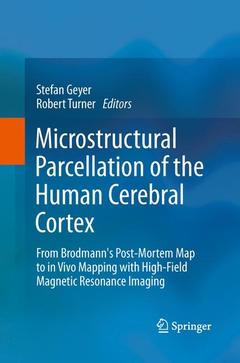Description
Microstructural Parcellation of the Human Cerebral Cortex, 2013
From Brodmann's Post-Mortem Map to in Vivo Mapping with High-Field Magnetic Resonance Imaging
Coordinators: Geyer Stefan, Turner Robert
Language: English
Subjects for Microstructural Parcellation of the Human Cerebral Cortex:
Publication date: 08-2015
Support: Print on demand
Publication date: 07-2013
257 p. · 15.5x23.5 cm · Hardback
Description
/li>Contents
/li>Comment
/li>
Unraveling the functional properties of structural elements in the brain is one of the fundamental goals of neuroscientific research. In the cerebral cortex this is no mean feat, since cortical areas are defined microstructurally in post-mortem brains but functionally in living brains with electrophysiological or neuroimaging techniques ? and cortical areas vary in their topographical properties across individual brains. Being able to map both microstructure and function in the same brains noninvasively in vivo would represent a huge leap forward. In recent years, high-field magnetic resonance imaging (MRI) technologies with spatial resolution below 0.5 mm have set the stage for this by detecting structural differences within the human cerebral cortex, beyond the Stria of Gennari. This provides the basis for an in vivo microanatomical brain map, with the enormous potential to make direct correlations between microstructure and function in living human brains.
This book starts with Brodmann?s post-mortem map published in the early 20th century, moves on to the almost forgotten microstructural maps of von Economo and Koskinas and the Vogt-Vogt school, sheds some light on more recent approaches that aim at mapping cortical areas noninvasively in living human brains, and culminates with the concept of ?in vivo Brodmann mapping? using high-field MRI, which was introduced in the early 21st century.
Guy N. Elston, Laurence J. Garey: The cytoarchitectonic map of Korbinian Brodmann: Arealisation and circuit specialization.- Lazaros C. Triarhou: The cytoarchitectonic map of Constantin von Economo and Georg N. Koskinas.- Rudolf Nieuwenhuys: The myelo architectonic studies on the human cerebral cortex of the Vogt - Vogt school, and their significance for the interpretation of functional neuroimaging data.- Bruce Fischl: Estimating the location of Brodmann Areas from cortical folding patterns using histology and ex vivo MRI.- Simon B. Eickhoff, Danilo Bzdok: Database-driven identification of functional modules in the cerebral cortex.- Robert Turner: Where matters: New approaches to brain analysis.- Robert Turner: MRI methods for in-vivo cortical parcellation.- Nicholas A. Bock, Afonso C. Silva: Visualizing myelo architecture in vivowith magnetic resonance imaging in common marmosets (Callithrix jacchus).- Stefan Geyer: High-field magnetic resonance mapping of the border between primary motor (area 4) and somatosensory (area 3a) cortex in ex-vivo and in-vivo human brains.
Explains why cortical areas and their boundaries are “classically” defined by their cyto- and myelo architectonic pattern in post-mortem brains
Illustrates how state-of-the-art high-field magnetic resonance imaging (MRI) technologies can generate in living brains individual-specific maps of cortical microstructure that are based on differential grey matter myelination between areas
Shows that the ultimate research goal is direct structure-function correlation in the same subjects, which can now be achieved by matching MRI-based microstructural and functional maps in the same living brains
Includes supplementary material: sn.pub/extras
These books may interest you

Association and Auditory Cortices 210.99 €



